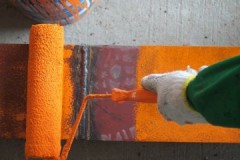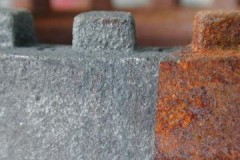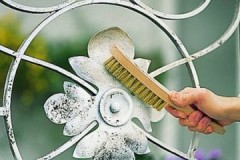Recipes and ways to quickly and effectively clean a cast iron pan from rust
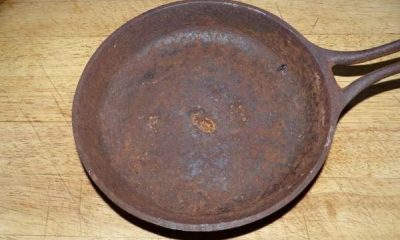 Thick-walled cast iron pans are valued for their durability and convenience in cooking. However, for a number of reasons, rust may appear on their surface.
Thick-walled cast iron pans are valued for their durability and convenience in cooking. However, for a number of reasons, rust may appear on their surface.
To remove plaque, use folk methods or special means from the category of household chemicals.
To protect cast iron from reoxidation, preventive measures and proper maintenance of the utensils must be taken.
We will tell you how to clean a cast-iron pan from rust in the article.
Content
Why does a rusty coating appear?
Why is there rust on the cast iron? Corrosion deposits on the surface of cast iron pans can appear for several reasons:
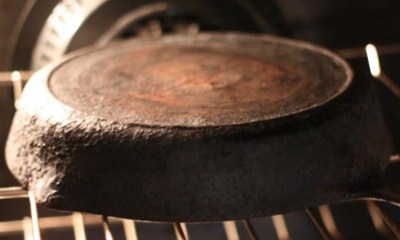 Manufacturing defect. It makes itself felt if poor-quality material was used in the manufacture of dishes or the rules for grinding the product were violated.
Manufacturing defect. It makes itself felt if poor-quality material was used in the manufacture of dishes or the rules for grinding the product were violated.- Illiterate first exploitation. It consists in ignoring the burning of the frying pan with oil after purchase.
- Storage of food in a dish. A damp surface and the presence of food for a long time leads to metal corrosion.
- Rare use of a frying pan for its intended purpose. The less often cast iron is heated, the more chemically active it is.
Folk remedies for home use
At home, you can use different methods of cleaning cast iron from rusty deposits. Each method has its own level of effectiveness and complexity of application. Common features of folk remedies are low financial costs and affordability.
Baking soda
Powder is poured onto the bottom of the dish and a small amount of water is added to form a pasty mass... This tool is rubbed with a soft sponge into rusty spots, after which the container is washed. If traces of rust remain, repeat the soda treatment.
How to clean with table salt?
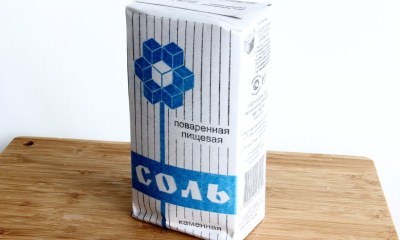 Fine or coarse salt can also help remove rusty deposits.
Fine or coarse salt can also help remove rusty deposits.
The agent in the amount of 3-5 tablespoons is poured into a bowl and ignited over a fire. Further dilute salt with water to a thick slurry and rub the damaged areas with a sponge.
If the rust cannot be removed the first time, repeat cleaning with salt or any other suitable means.
Vinegar
For cleaning, a small amount of acetic acid is poured into the dishes and left to soak for several hours.
The method is one of the most effective, since iron oxide and hydroxide react with acetic acid, as a result of which rust disappears from the surface of the pan without heating and physical effort.
How to get rid of with Coca-Cola?
A container that is larger than the pan is filled with Coca-Cola and heated. Dip a frying pan into a bowl and stand for 40-60 minutes.
The phosphoric acid in the drink reacts and reduces the amount of oxidized iron... Instead of Coca-Cola, you can take any other carbonated drink with similar qualities. The method is considered safe, simple and effective.
Mechanical cleaning
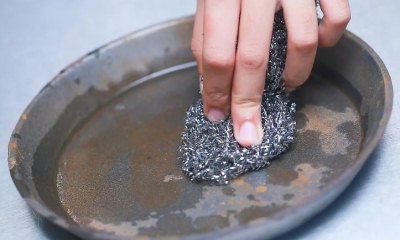 Rust can be scrubbed off the surface of the pan with a steel wool or a stiff brush. The dishes are rubbed until the orange bloom disappears completely.
Rust can be scrubbed off the surface of the pan with a steel wool or a stiff brush. The dishes are rubbed until the orange bloom disappears completely.
The method is the cheapest, but laborious, as it requires the application of physical effort.
An alternative to a metal sponge can be a sander with a fine sandpaper attachment. The method is effective and expedient if a thick layer of rust has formed on the dishes, which is difficult to remove with a soft converter.
Special formulations
Rust removal liquids and concentrates contain highly potent substances. They provide high efficiency, but require precautions.
Sanita Anti-rust
A well-known Russian brand produces a gel-like universal rust remover on metal surfaces. The concentrate contains organic acids, including oxalic... They account for up to 30% of all components. The number of nonionic surfactants is less than 5%.
The gel is applied with a sponge or brush on the rust and left for 3-4 minutes to react. The maximum holding time (with a thick rusty layer) can be 10 minutes. Next, the surface is cleaned with a brush or a coarse sponge and thoroughly washed in water. A 500 ml bottle is sold in stores for 85-105 rubles.
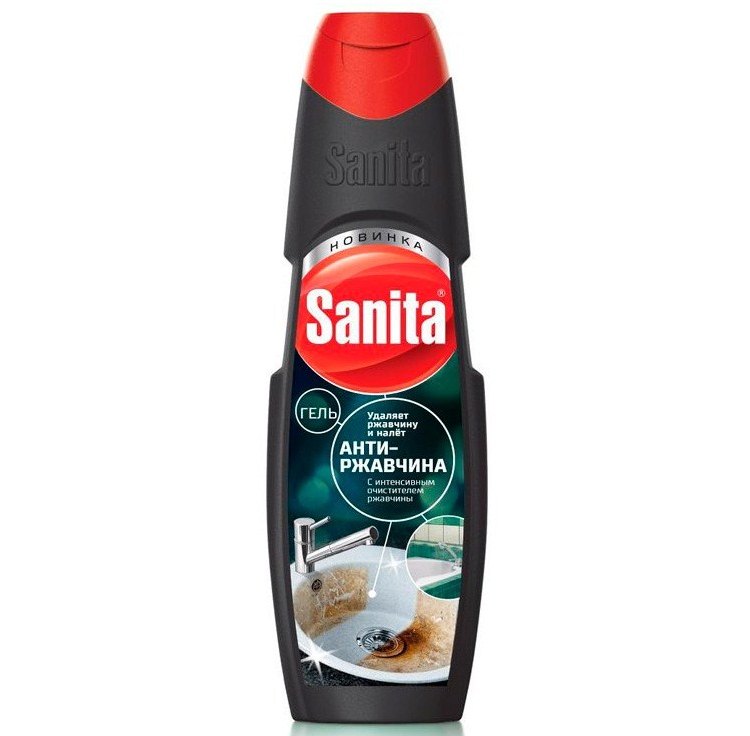
Cillit BANG
A universal Russian-made product designed to remove rust and limescale. The gel formula contains no more than 5% non-surfactant. The active ingredient is oxalic acid.
To clean the surface, it is first moistened with water. Apply Cillit BANG to the sponge and wipe the rusty areas. The exposure time depends on the thickness of the plaque and ranges from one to five minutes. After that, the dishes are washed in a large volume of water. The cost of a 450 ml bottle is on average 230 rubles.
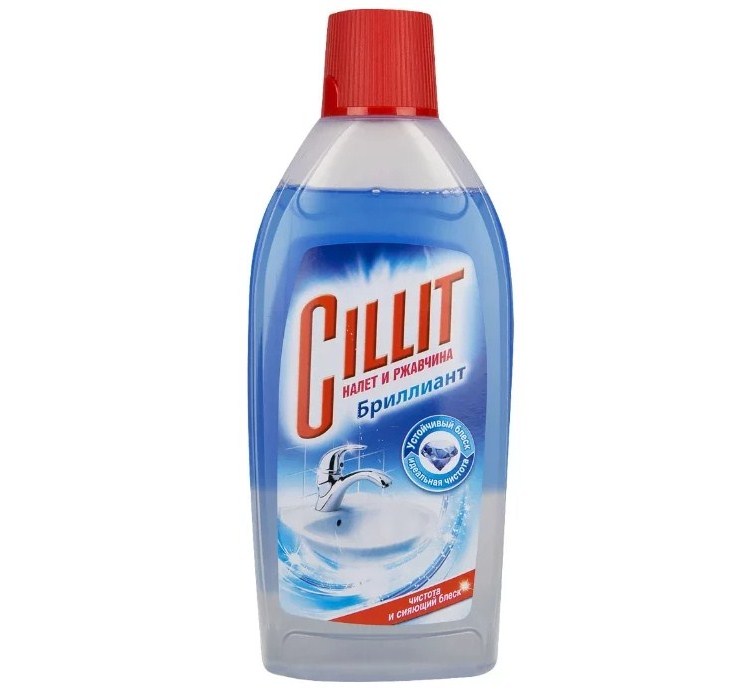
Syntilor Ruggine
Concentrated liquid rust remover from a Russian manufacturer. The product is intended for cleaning metal surfaces. The composition does not contain chlorine and mercury-containing substances. The rust converter is considered safe for human health and the environment, and can be discharged into the general sewer.
Before use, shake the product, dilute with water in a 1: 3 ratio and apply with a sponge on rusty spots.... Leave the dishes for 5-8 minutes for the reaction to take place. Next, clean the surface with a stiff brush. The procedure is completed by rinsing with water. The average price for a 1 kg bottle is 300 rubles.
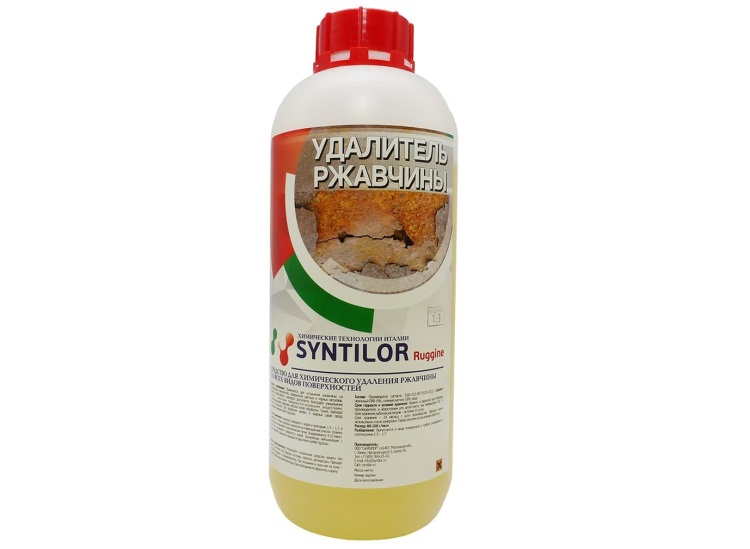
What cannot be used and for what reason?
It is not recommended to use foaming detergents for cleaning and washing cast iron dishes. They provide a degreasing effect and remove protective oil impregnation. Open pores of cast iron free the access of moisture to the metal and initiate the corrosion process.
Do not use metal brushes without special need.... They damage the protective coating and make the cast iron surface vulnerable to moisture and chemicals.
How to restore the protective layer?
After any cleaning, the pan is rinsed with plenty of water and wiped dry with a towel or napkin. After that, they begin to create a protective layer that protects the cast iron from corrosion.
The work includes several steps:
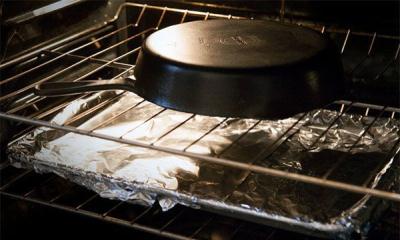 heat the oven to 180 degrees;
heat the oven to 180 degrees;- grease the pan with a thin layer of vegetable oil;
- put the dishes in the oven upside down;
- ignite the pan for an hour;
- keep the dishes in the oven until they cool completely;
- the pan is washed with warm water, wiped dry.
For coating a frying pan, it is allowed to use any kind of vegetable oil, except olive oil (it smokes when fired), as well as any kind of animal fat.
Oil and melted fat penetrate the micropores of the cast iron, creating a waterproof coating. This method of protection must be used after each cleaning of the dishes, regardless of the agent used.
Corrosion prevention and care recommendations
So that the cast iron pan does not cause problems, it is necessary to adhere to the care rules during the entire period of operation:
- Cast iron cookware is not intended for storing food, as a humid environment provokes corrosive processes. The food is removed from the pan immediately after cooking.
- After cooking, a frying pan that has not yet cooled down should not be immediately placed under cold water; it needs time to cool naturally.
- It is recommended to keep the oily impregnation throughout the entire service life. If the protective layer has disappeared, it must be restored.
- It is advisable not to fry or stew products with an acidic reaction in a cast-iron dish (tomatoes, pickles, citrus fruits, sauerkraut).
- If the food is burnt, then the pan is poured with water, heated over a fire and given time to soak. This will allow you to do without hard washcloths and soap, which removes the protective layer.
Advice
When cleaning, it is recommended to give preference to more gentle methods and means... Mechanical grinding is one of the most aggressive methods, so it should only be used as a last resort.
Rinse the pan under running hot water using a soft sponge in parallel. After removing the rust, the container should be well dried with a towel or by heating over a fire.
Related videos
How to clean a cast-iron pan from rust, the video will tell you:
Conclusion
To safely use a cast iron frying pan, you need to understand the causes of rust, know how to remove it and remember about preventive measures.
The cleansing procedure is carried out both with the help of folk remedies and by using ready-made household chemicals... To select an appropriate solution to the problem, the oxidation state of the alloy and financial capabilities are evaluated.

